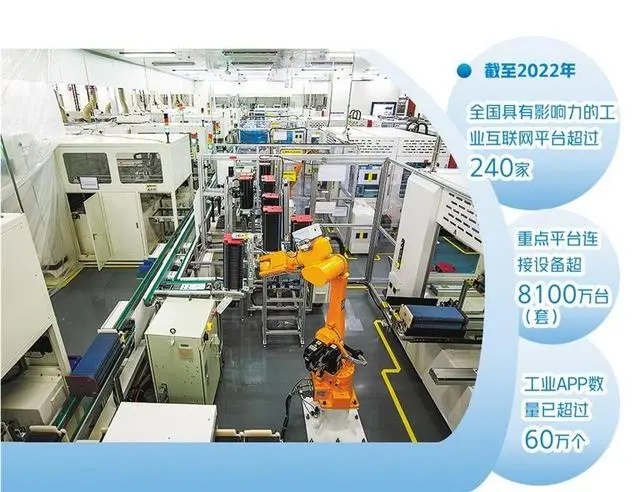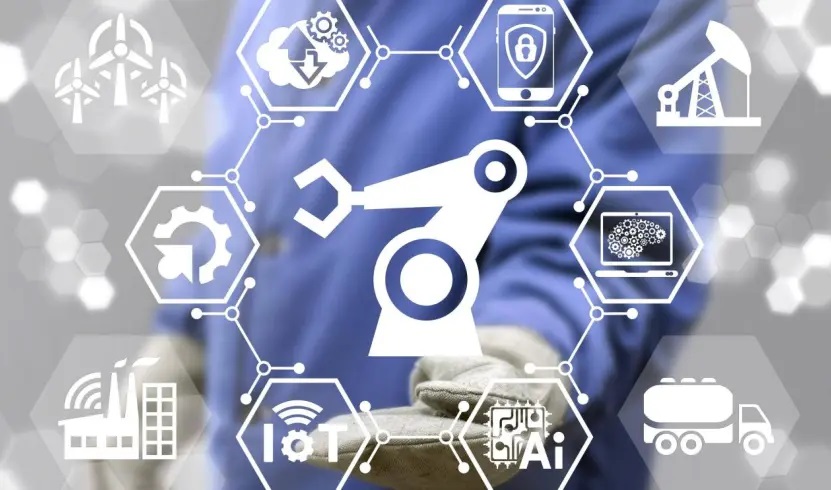The China Industrial Internet Research Institute recently released the “China Industrial Internet Platform Innovation and Development Report”. The “Report” believes that my country’s industrial Internet platform construction has made positive progress. As of 2022, there will be more than 240 influential industrial Internet platforms in the country, and more than 81 million devices (sets) connected to key platforms. The number of industrial APPs has exceeded 600,000. In 2022, the number of “double-span” platforms will increase to 28, and 72 new distinctive industrial Internet platforms will be added.

“The Industrial Internet is a new strategic infrastructure for industrialization and a key base for the deep integration of the digital economy and the real economy.” Zhao Zhiguo, chief engineer of the Ministry of Industry and Information Technology, introduced that the “Industrial Internet Innovation and Development Action Plan (2021-2023)” has been implemented for two years. Over the past many years, the Ministry of Industry and Information Technology has adhered to the principle of moderate advancement and has fully completed the infrastructure. The industrial Internet logo analysis system covers 31 provinces and 40 industries, serving more than 250,000 companies, forming a comprehensive, characteristic, and professional multi-level industrial Internet platform system.
At the same time, the development of my country’s industrial Internet platform has always been demand-oriented, and integrated applications have continued to expand in depth. “Industrial Internet platform applications have covered many major categories of the national economy, forming six major application models: platform design, intelligent manufacturing, networked collaboration, personalized customization, service extension, and digital management. The platform promotes the upstream and downstream of the industrial chain, large-scale The integrated development of small and medium-sized enterprises has increasingly demonstrated its role in improving quality, reducing costs, increasing efficiency, greening and safety.” Lu Chuncong, president of the China Industrial Internet Research Institute, said that the rapid growth of industrial Internet platforms stems from the genes of traditional manufacturing companies. For example, Haier Kaos in the home appliance manufacturing industry, XCMG Hanyun in the construction machinery industry, Baoxin Software in the steel industry, etc. The advantage of this type of platform is that it has richer industrial knowledge, mechanisms, and experience, and has a better understanding of the industry’s digital transformation needs. On the other hand, it comes from the genes of information and communication enterprises. Such as Inspur Yunzhou and China Electronics Internet. The advantages of this type of platform are reflected in its years of practice and accumulation in the ICT industry. It has relatively strong production and operation and maintenance capabilities for information and communication equipment serving manufacturing scenarios. It forms a product value advantage by building an industrial Internet infrastructure base.

AGV vehicles automatically transport materials and RGV vehicles assist in process conversion. A 5,400-square-meter production workshop of Shandong Electric Group Xinneng Technology Co., Ltd. now only requires 39 staff to complete daily production. According to reports, the company relies on the Inspur Yunzhou Industrial Internet platform to build a digital workshop. By installing sound, light, electricity and other sensors, it realizes the interconnection between equipment and people, and establishes a more scientific, standardized and standard full-process management system.
“Through the empowerment of Inspur Yunzhou, our production efficiency has increased by 27%, the first-time product qualification rate has increased by 17%, and the comprehensive operating costs of the workshop have been reduced by 17%.” Xue Junjie, director of the company’s production and manufacturing center, said that last year the company invested more than 2,000 Ten thousand yuan was used for digital transformation, and the comprehensive benefit increased by 5.33 million yuan that year. This year’s self-produced output value target is twice that of last year, reaching 380 million yuan.
In the first quarter of this year, the Ministry of Industry and Information Technology released 218 industrial Internet pilot demonstration projects such as 5G factories, industrial Internet parks, and public service platforms, creating a number of application practice models to drive factories and parks to accelerate digital transformation. At present, the scale of the core industrial Internet industry exceeds 1.2 trillion yuan, an increase of 15.5% over the same period.
“5G is the key technology driving the development of the industrial Internet, and the industrial Internet is the main battlefield for large-scale applications of 5G. The deep integration of the two will further release the application value of the technology.” Liu Liehong, chairman of China Unicom, said that the company has built more than 8,500 “5G Industrial Internet” project has built more than 2,000 5G factory projects, covering 20 application scenarios. In Guangdong, China Unicom and Midea cooperated to build a 5G smart factory, and 5G sub-meter integrated positioning smart warehousing was commercially launched, reducing logistics inventory by 30%; in Chongqing, 5G LAN (local area network), cloud PLC (programmable logic Controller) and other technologies are applied to Changan Automobile’s 5G workshop to achieve flexible production and save 30% of maintenance costs.
“The development of the industrial Internet has entered the fast lane, but to achieve large-scale application, it must be further penetrated into industrial sites and penetrated into core production links.” Liang Baojun, deputy general manager of China Unicom, said that industrial Internet security must also be strengthened. Risks such as exposure of industrial control systems and equipment are gradually expanding. In view of the current construction situation such as the difficulty of updating and upgrading old equipment, the market is in urgent need of security service providers and product providers who understand industrial manufacturing.
Xu Xiaolan, Vice Minister of the Ministry of Industry and Information Technology, also believes that the key to stimulating the vitality of the integrated application of the industrial Internet is to be driven by demand. It is necessary to implement industry-specific policies to guide traditional industries to do the “must-answer questions” of digital transformation, and use the industrial Internet to carry out all-round and full-chain digitalization. Transformation. Put the digital transformation of small and medium-sized enterprises in a prominent position, give full play to the leading role of large enterprises, promote the chain transformation of upstream and downstream enterprises in the industrial chain, and promote the improvement of the industrial Internet from “useful” to “effective”. At the same time, it is necessary to strengthen policy guidance and coordinate the construction of network, platform, data, security and standard systems. Accelerate technological research in key areas such as advanced computing, industrial networks, industrial chips, industrial intelligence, industrial models, and network security. Improve the industrial supply level of terminals, networks, edges, clouds, and applications, and accelerate the integration and innovation of common and personalized technologies in the industrial Internet.
“The construction and promotion of the industrial Internet platform is a systematic project that requires the coordinated efforts of all parties involved in industry, academia, and research. It is necessary to use marketization, diversified social financing, and use capital as a link to gather various element resources such as talent, technology, and data, in order to Promote the collaboration of factors among enterprises and support platform enterprises to continue to expand their scale and release their vitality.” Lu Chuncong said that deepening the integrated development of IT (information technology) and OT (operational technology) is the main direction of digital transformation, and there is still a lot to be done in industrial digital transformation. There is a long way to go, and we must be prepared for a team battle, a tough battle, and a protracted battle.